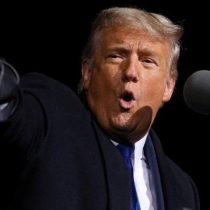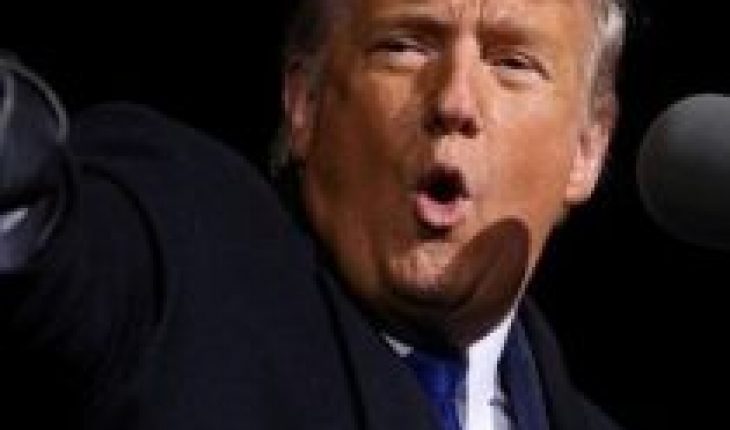
Former federal prosecutor James Zirin, who investigated for more than three years the litigation Trump has been involved in, says that in his public life the president has resorted extensively to the courts when he is in trouble.
“Trump has turned the justice system into a weapon throughout his careerZirin writes.
“He sees the law not as a system of rules to be obeyed or ethical ideals that must be respected, but as a weapon that must be used against his adversaries or an obstacle that must be overcome when he stands in his way,” he adds.
BBC Mundo tried to contact the president’s campaign to learn about it, but for the time being it did not get an answer.
The representative himself has on other occasions been effusive for his participation in legal proceedings.
“Does anyone know more about litigation than Trump?” he said of himself in the 2016 election campaign.
“It’s like I have a PhD in litigation,” he added.
A wide career
Indeed, the president’s career in demand is extensive.
Zirin’s research for his book “Plaintiff-in-chief“ indicates that, until 2016, shortly before reaching the White House, Trump had been embroiled in one way or another 3,500 lawsuits within 30 years.
Meanwhile, another investigation of the diary USA TODAY found that, even during the presidency, the account of his litigation increased to a total of 4.095. That is, an average of 137 per year over the past three decades.
Tim O’Brien, one of the representative’s biographers, says Trump has historically used litigation “to keep hostile forces at bay and delay account adjustments.”
“He has also used them to try to embarrass competitors, critics or opponents. And I think he’s generally done it successfully,” he wrote.
According to an investigation by the newspaper The New York Times published last October, the court strategy helped Trump even get banks and lenders forgive him debts, fearing he would be embroiled in a court proceeding with such a given figure to the headlines.
One of the cases, according to the newspaper, led to him being forgiven almost $300 million on loans for a failed real estate project in a Chicago skyscraper.
“When the project encountered problems, (Trump) tried to get away from his huge debts. For most people or businesses, that would have been a recipe for ruin,” the report states.
But data from tax returns, other records and interviews conducted by the newspaper showed that, in order not to battle “against a client notoriously famous for his litigation and in search of headlines,” lenders forgave him for debt.
“Even after Trump sued his biggest lender (…) the bank agreed to lend it another $99 million (…) so that it could repay what it still owed the bank, Chicago’s unfulfilled loan,” he says.
“Ultimately, Trump’s lenders forgave him much of what he owed,” he adds.
The sources of lawsuits
Both Zirin and Trump’s biographer have pointed out that the representative learned the technique of going to court from his former lawyer Roy Cohn, who in 1970s Manhattan became known for defending mafia-linked figures and bribing courts.
“Trump took Cohn’s razed earth strategy seriously and used the law to attack others, never accept guilt or responsibility, and to always claim victory no matter how much he lost,” Zirin writes in his book.
Her record, according to a compilation of Crush the LSAT, the publication that prepares lawyers for leave in the U.S., ranges from brand use cases with her name or debt claims from her casinos to the so-called Trump University scandal, which was accused of defrauding her students by using deceptive marketing practices.
Other notorious cases have ranged from lawsuits to banks or football teams to accusing a book author who called him a “millionaire” and not “billionaire” or multiple litigation against Palm Beach County, Florida, where his Mar-a-Lago club is, one of them for “diverting air traffic” over his property.
According to Zirin’s book and research into the specialized environment Political demands did not change tone when Trump came to the White House.
“As a developer (of real estate), he loved to take his enemies to court. As president, he continues to apply the same aggressive game manual,” he said Political.
Shortly after his promotion, among other cases, Trump “returned” a lawsuit to pornographic actress Stormy Daniels, who had previously also accused him, and in one of the most recent cases earlier this year, accused The New York Times, the Washington Post and CNN of allegedly defaming his re-election campaign.
However, according to Zirin’s investigation and USA TODAY’s account, the representative, as in Daniels’ case, has not only been on the plaintiff’s side, but also with the defendant.
Until 2016, when he ran for the White House, there were 160 federal litigation pending against him, as well as numerous legal investigations, including problems with his tax returns.
According to Zirin, over the years, the president “has been sued for racial and sexual discrimination, sexual harassment, fraud, abuse of trust, money laundering, defamation, abuse of his creditors, voter fraud and loan default,” among others.
Because of the immunity offered by the office, pending legal proceedings and those that have arisen in recent years are halted, but if the White House is lost, the picture could be different.
Trump bluntly denies committing any wronglessness and claims there is a “witch hunt” against him when he has tried to investigate his management.
Games with the system
Critics of the president, however, have pointed out in recent years that their previous games with the courts have now led them to try to use the Justice Department in their favor.
Several federal exfiscales have accused the current head of the Department, William Barr, to try to benefit the president or to hide information that may be harmful to him.
Last month, a federal judge rejected the Justice Department’s proposal to turn the U.S. government into the defendant, rather than Trump, into a defamation lawsuit against the president.
And despite various orders from judges and Congress, the representative has also played with several lawsuits that have escalated to the Supreme Court to prevent their financial records and tax returns from being made public.
Trump has not only been the president that has appointed the most federal judges in recent decades, but also managed to fill in less than four years three Supreme Court seats, the last of them less than a month into the election.
Three days after Judge Ruth Bader Ginsburg’s death in September, Trump met at the White House with Amy Coney Barrett to discuss his court nomination.
Two days later, the president said it was “very important“that his nominee would be confirmed before the election so that the highest court could stop “this scam that Democrats are doing,” in alleged reference to mail voting because of the coronavirus pandemic.
“I think this (the election) will end up on the Supreme Court,” Trump said on September 23. “In case it’s more political (the electoral process) than it should be, I think it’s very important to have a ninth judge,” he added in reference to Coney Barrett, finally elected.
Trump’s announcement of refusing to accept his defeat to Biden creates a situation as new as it is disconcerting in U.S. life.
It remains to be seen whether the new U.S. president will decide the votes or the courts.





